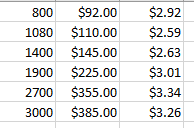Hi Guys,
I just got a TS75 w/o a guide rail from Recon. I currently have no other rails nor rail-compatible festool products (but plan to pick up an OF2200 in the near future). My question is, given that I have a tiny shop, is there any problem with getting two of the 55" rails and connectors vs 1 55" and 1 106" inch? I don't mind the extra time it takes to assemble the two segments but is it difficult to achieve perfect alignment between the segments? My Kreg ACS rails have a similar looking connector system and I usually spend about 5 minutes futzing with the straight edge and rails trying to get it all lined up and it never leaves me feeling that it is "perfect". I've read some other comments about the Festool brand connectors not being great and some other brands being superior. Any thoughts on that topic would be appreciated as well.
Second question, for the 55" (1400) size which I know I will be getting either way, is there any reason to not get the LR version with the holes? I'm honestly not aware of all the things this system can do and how much I would or wouldn't use those features, but given that it is the same price as the non-hole 1400 is this is a no-brainer decision or is there some reason you wouldn't want the LR version?
Thanks!
Jeff
I just got a TS75 w/o a guide rail from Recon. I currently have no other rails nor rail-compatible festool products (but plan to pick up an OF2200 in the near future). My question is, given that I have a tiny shop, is there any problem with getting two of the 55" rails and connectors vs 1 55" and 1 106" inch? I don't mind the extra time it takes to assemble the two segments but is it difficult to achieve perfect alignment between the segments? My Kreg ACS rails have a similar looking connector system and I usually spend about 5 minutes futzing with the straight edge and rails trying to get it all lined up and it never leaves me feeling that it is "perfect". I've read some other comments about the Festool brand connectors not being great and some other brands being superior. Any thoughts on that topic would be appreciated as well.
Second question, for the 55" (1400) size which I know I will be getting either way, is there any reason to not get the LR version with the holes? I'm honestly not aware of all the things this system can do and how much I would or wouldn't use those features, but given that it is the same price as the non-hole 1400 is this is a no-brainer decision or is there some reason you wouldn't want the LR version?
Thanks!
Jeff

